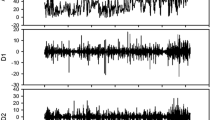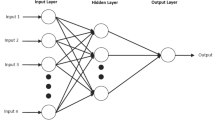Abstract
Eddy covariance (EC)-measured data were used to develop multiple nonlinear regression (MNLR) models of latent (LE) and sensible heat (H s) fluxes, and micrometeorological station-measured actual evapotranspiration (ET). Discrete wavelet transform (DWT) with symmlets (sym10), coiflets (coif10), and daubechies (db10) was used to decompose time series signals of LE, H s, and ET into frequency components in order to feed denoised output data into 26 artificial neural networks (ANNs) with different learning algorithms, based on independent validation-derived values of coefficient of determination (r 2), root mean square error (RMSE), mean absolute error (MAE), wavelet neural networks (WNNs) with coif10-1 and db10-1 outperformed ANNs, and MNLR models. The best ones out of 26 WNNs appeared to be multilayer perceptrons (MLPs) for LE and H s, and time-delay network (TDNN) for ET, while the best ones out of 26 ANNs were determined as TDNN for LE, MLP for H s, and generalized feedforward network (GFF) for ET. The combination of batch mode and Levenberg–Marquardt algorithm was adopted in the ANNs and WNNs more frequently and generated better accuracy metrics than the combinations of online mode and Momentum algorithm, and batch mode and Momentum algorithm.









Similar content being viewed by others

References
Baldocchi D, Falge E, Gu L, Olson R, Hollinger D, Running S, Anthoni P, Bernhofer Ch, Davis K, Evans R, Fuentes J, Goldstein A, Katul G, Law B, Lee X, Malhi Y, Meyers T, Munger W, Oechel W, Paw KTU, Pilegaard K, Schmid HP, Valentini R, Verma S, Vesala T, Wilson K, Wofsy S (2001) FLUXNET: a new tool to study the temporal and spatial variability of ecosystem-scale carbon dioxide, water vapor, and energy flux densities. Bull Am Meteorol Soc 82(11):2415–2434
Jung M, Reichstein M, Margolis H, Cescatti A, Richardson A, Arain A, Arneth A, Bernhofer C, Bonal D, Chen J, Gianelle D, Gobron N, Kiely G, Kutsch W, Lasslop G, Law B, Lindroth A, Merbold L, Montagnani L, Moors E, Papale D, Sottocornola M, Vaccari FP, Williams C (2011) Global patterns of land-atmosphere fluxes of carbon dioxide, latent heat, and sensible heat derived from eddy covariance, satellite, and meteorological observations. J Geophys Res 116:G00J07
Kumar M, Bandyopadhyay A, Raghuwanshi NS, Singh R (2008) Comparative study of conventional and artificial neural network-based ETo estimation models. Irrigation Sci 26(6):531–545
Parasuraman K, Elshorbagy A (2008) Toward improving the reliability of hydrologic prediction: model structure uncertainty and its quantification using ensemble-based genetic programming framework. Water Resour Res 44:W12406
Kumar M, Raghuwanshi NS, Singh R, Wallender WW, Pruitt WO (2002) Estimating evapotranspiration using artificial neural network. J Irrig Drain E-ASCE 128(4):224–233
Trajkovic S (2005) Temperature-based approaches for estimating reference evapotranspiration. J Irrig Drain E-ASCE 131(4):316–323
Jain SK, Nayak PC, Sudheer KP (2008) Models for estimating evapotranspiration using artificial neural networks, and their physical interpretation. Hydrol Process 22(13):2225–2234
Landeras G, Ortiz-Barredo A, Lopez JJ (2008) Comparison of artificial neural network models and empirical and semi-empirical equations for daily reference evapotranspiration estimation in the Basque Country (Northern Spain). Agric Water Manage 95(5):553–565
Chauhan S, Shrivastava RK (2009) Performance evaluation of reference evapotranspiration estimation using climate based methods and artificial neural networks. Water Resour Manage 23(5):825–837
Sudheer KP, Gosain AK, Ramasastri KS (2003) Estimating actual evapotranspiration from limited climatic data using neural computing technique. J Irrig Drain E-ASCE 129:214–218
Parasuraman K, Elshorbagy A, Carey SK (2006) Spiking modular neural networks: a neural network modeling approach for hydrological processes. Water Resour Res 42:W05412
Parasuraman K, Elshorbagy A, Carey SK (2007) Modeling the dynamics of the evapotranspiration process using genetic programming. Hydrolog Sci J 52:563–578
Abareshi B, Schuepp PH (1998) Sensible heat flux estimation over the FIFE site by neural networks. J Atmos Sci 55:1185–1197
Wang WG, Luo YF (2007) Wavelet network model for reference crop evapotranspiration forecasting. In: Proceedings of international conference on wavelet analysis and pattern recognition, China
Brunsell NA, Ham JM, Owensby CE (2008) Assessing the multi-resolution information content of remotely sensed variables and elevation for evapotranspiration in a tall-grass prairie environment. Remote Sens Environ 112(6):2977–2987
Kaheil YH, Rosero E, Gill MK, McKee M, Bastidas LA (2008) Downscaling and forecasting of evapotranspiration using a synthetic model of wavelets and support vector machines. IEEE T Geosci Remote 46(9):2692–2707
Partal T (2009) Modelling evapotranspiration using discrete wavelet transform and neural networks. Hydrol Process 23(25):3545–3555
Webb EK, Pearman GI, Leuning R (1980) Correction of flux measurements for density effects due to heat and water vapour transfer. Q J Roy Meteor Soc 106:85–100
Olson RJ, Hollady SK, Cook RB, Falge E, Baldocchi D, Gu L (2004) Fluxnet: database of fluxes: site characteristics, and flux-community information. Oak Ridge National Laboratory ORNL/TM-2003/204
Thomas MV, Malhi Y, Fenn KM, Fisher JB, Morecroft MD, Lloyd CR, Taylor ME, McNeil DD (2011) Carbon dioxide fluxes over an ancient broadleaved deciduous woodland in southern England. Biogeosciences 8:1595–1613
Twine TE, Kustas WP, Norman JM, Cook DR, Houser PR, Meyers TP, Prueger JH, Starks PJ, Wesley ML (2000) Correcting eddy-covariance flux underestimates over a grassland. Agr Forest Meteorol 103:279–300
Xiao X, Zuo HC, Yang QD, Wang SJ, Wang LJ, Chen JW, Chen BL, Zhang BD (2011) On the factors influencing surface-layer energy balance closure and their seasonal variability over semi-arid loess plateau of Northwest China. Hydrol Earth Syst Sc Discus 8:555–584
Kang SJ, Lin H (2007) Wavelet analysis of hydrological and water quality signals in an agricultural watershed. J Hydrol 338:1–14
Koirala SR, Gentry RW, Mulholland PJ, Perfect E, Schwartz JS (2010) Time and frequency domain analyses of high-frequency hydrologic and chloride data in an east Tennessee watershed. J Hydrol 387:256–264
Coulibaly P, Anctil F, Aravena R, Bobee B (2001) Artificial neural network modeling of water table depth fluctuations. Water Resour Res 37:885–896
Bishop CM (1996) Neural networks for pattern recognition, 1st edn. Oxford University Press, Oxford
Ripley BD (1996) Pattern recognition and neural networks, 1st edn. Cambridge University Press, New York
Penman HL (1948) Natural evaporation from open water, bare soil and grass. P Roy Soc Lond 193:120–146
Monteith JL (1965) the state and movement of water in living organisms. In: Proceedings of evaporation and environment of the 19th symposium of society for experimental biology. Cambridge University Press, New York
Doorenbos J, Pruitt WO (1977) Crop water requirements. FAO Irrigation and Drainage Paper 24, Food and Agriculture Organization, Rome
Turc L (1961) Estimation of irrigation water requirements, potential evapotranspiration: a simple climatic formula evolved up to date. Ann Agron 12:13–14
Allen RG, Pereira LS, Raes D, Smith M (1998) Crop evapotranspiration. FAO irrigation and drainage paper no 56, Food and Agriculture Organization, Rome
Dai X, Shi H, Li Y, Ouyang Z, Huo Z (2009) Artificial neural network models for estimating regional reference evapotranspiration based on climate factors. Hydrol Process 23(3):442–450
Wang Y, Traore S, Kerh T (2008) Neural network approach for estimating reference evapotranspiration from limited climatic data in Burkina Faso. WSEAS T Comput 7(6):704–713
Trajkovic S, Todorovic B, Stankovic M (2003) Forecasting reference evapotranspiration by artificial neural networks. J Irrig Drain E-ASCE 129(6):454–457
Kisi O (2006) Evapotranspiration estimation using feed-forward neural networks. Nord Hydrol 37(3):247–260
Aghajanloo M-B, Sabziparvar A–A, Talaee PH (2012) Artificial neural network-genetic algorithm for estimation of crop evapotranspiration in a semi-arid region of Iran. Neural Comput Appl. doi:10.1007/s00521-012-1087-y (in press)
Lotric U, Dobnikar A (2005) Predicting time series using neural networks with wavelet-based denoising layers. Neural Comput Appl 14(1):11–17
Acknowledgments
This research was funded by the Scientific and Technological Research Council of Turkey (TUBITAK) (Grant no: CAYDAG-109Y186 and COST-ES0903). The author is grateful to invaluable comments of the three anonymous reviewers whose comments significantly improved an earlier version of the manuscript.
Author information
Authors and Affiliations
Corresponding author
Rights and permissions
About this article
Cite this article
Evrendilek, F. Assessing neural networks with wavelet denoising and regression models in predicting diel dynamics of eddy covariance-measured latent and sensible heat fluxes and evapotranspiration. Neural Comput & Applic 24, 327–337 (2014). https://doi.org/10.1007/s00521-012-1240-7
Received:
Accepted:
Published:
Issue Date:
DOI: https://doi.org/10.1007/s00521-012-1240-7



